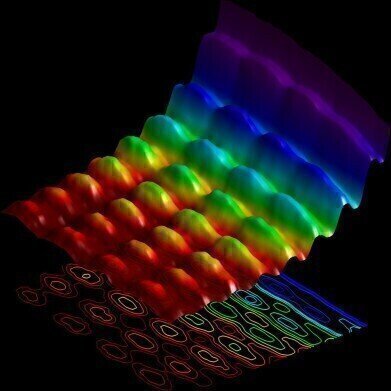News & Views
Simultaneous Particle and Wave Behaviour? Scientists Claim That It Is Possible!
Mar 10 2015
Scientists have uncovered a revolutionary new discovery and maintain that they have captured light behaving as both a particle and a wave, at the same time. The claim is backed by the world’s first pictorial evidence that captures light taking on the dual forms simultaneously.
New life breathed into an old theory
The world was first introduced to the idea of light particles back in 1905 when Albert Einstein put forward his famous ‘photoelectric effect’ theory. It occurs when particles of light bounce of a metal surface and emanate photoelectrons. However if the light is beamed in wave form this effect doesn’t occur. At least that’s what scientists thought until now.
Led by Fabrizio Carbone, a team from the École polytechnique fédérale de Lausanne has recently discovered that light can simultaneously behave as both a wave and a particle. The new findings were published in a paper titled "Simultaneous observation of the quantization and the interference pattern of a plasmonic near-field" and have created quite the buzz in the science sphere.
Carbone explains, "This experiment demonstrates that, for the first time ever, we can film quantum mechanics -- and its paradoxical nature – directly."
Snap happy scientists
To capture the photo Carbone developed a unique apparatus that directs a beam of laser light towards a metallic nanowire made up of charged particles. Upon contact the laser energised the particles which caused them to vibrate. This then emitted light waves in two opposite directions down the nanowire. When the two beams met they created a standing wave. The wave was then introduced to a stream of electrons which either increased or decreased their speed. Meanwhile the process was captured using an ultrafast microscopic camera.
While the standing wave was the expected form, the electrons also indicated that it contained particles. When they met the photons and underwent a change in speed the energy exchange induced evidence of particle behaviour within the standing form.
The next era of computing
According to Carbone the new findings could be incredibly valuable to the computing sector, with the scientist explaining that "Being able to image and control quantum phenomena at the nanometer scale like this opens up a new route towards quantum computing."
Using the new knowledge that light can take the form of a wave and a particle at the same time engineers could be able to develop next generation quantum computers capable of exceptional performance. These will be able to process data at phenomenal speeds and seriously augment the operations of a myriad of sectors, from civilian, business and trade to gaming and national security. The discovery also comes in the wake of recent cutting edge Google and the University of California advancements that have created quantum computers that are faster, more intelligent and far more stable.
More amazing images!
If you love this picture, then you may be excited to hear that images from around the world defining what we see on the largest and smallest scales, including some that are normally invisible to the human eye, are just part of a new photography exhibition which opened in London and is currently on a national tour. For more information, read: Incredible Images Launch International Year of Light 2015.
Image Credit: Fabrizio Carbone/EPFL
Digital Edition
LMUK 49.7 Nov 2024
November 2024
News - Research & Events News - News & Views Articles - They’re burning the labs... Spotlight Features - Incubators, Freezers & Cooling Equipment - Pumps, Valves & Liquid Hand...
View all digital editions
Events
Nov 18 2024 Shanghai, China
Nov 20 2024 Karachi, Pakistan
Nov 27 2024 Istanbul, Turkey
Jan 22 2025 Tokyo, Japan
Jan 22 2025 Birmingham, UK




.jpg)














